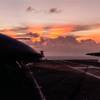While acknowledging concerns to the daunting problem of guarding America's ports, the government is pursuing new technology to protect the nation. But some business leaders complain there is no clear strategy, and they are concerned about who is going to pay the bill. By summer's end, more than 400,000 port workers will be matched against the terrorist watch lists as the first major step to tighten port security. Ultimately, by year's end, all 750,000 workers with unrestricted access to ports will need tamper-free identification cards. But with the government planning to spend hundreds of millions for new technology to safeguard U.S. ports, some businesses wonder about the risks and benefits of the new tools. Besides security checks for workers, Homeland Security wants a "new generation of tools" to detect nuclear materials and to better screen all inbound cargo, such as radiation monitors that would be used to inspect some of the 11 million cargo containers entering the United States daily. Already, 214 monitors are in place, screening more than half the cargo entering U.S. ports for radiation, officials said. By the end of next year, they said, 621 monitors will be installed capable of screening 98 percent of incoming shipments. Customs officials say that there will be enough money in the budget to purchase and install the monitors. (Source: FXStreet.com)
Featured videos

Tracking Foreign Vessels Working in the U.S. Jones Act Market

Inside the Electrified Truckable Tug

Inmarsat Enhances Service to Drive Digitalization
Subscribe for
Maritime Reporter E-News
Maritime Reporter E-News is the maritime industry's largest circulation and most authoritative ENews Service, delivered to your Email five times per week









